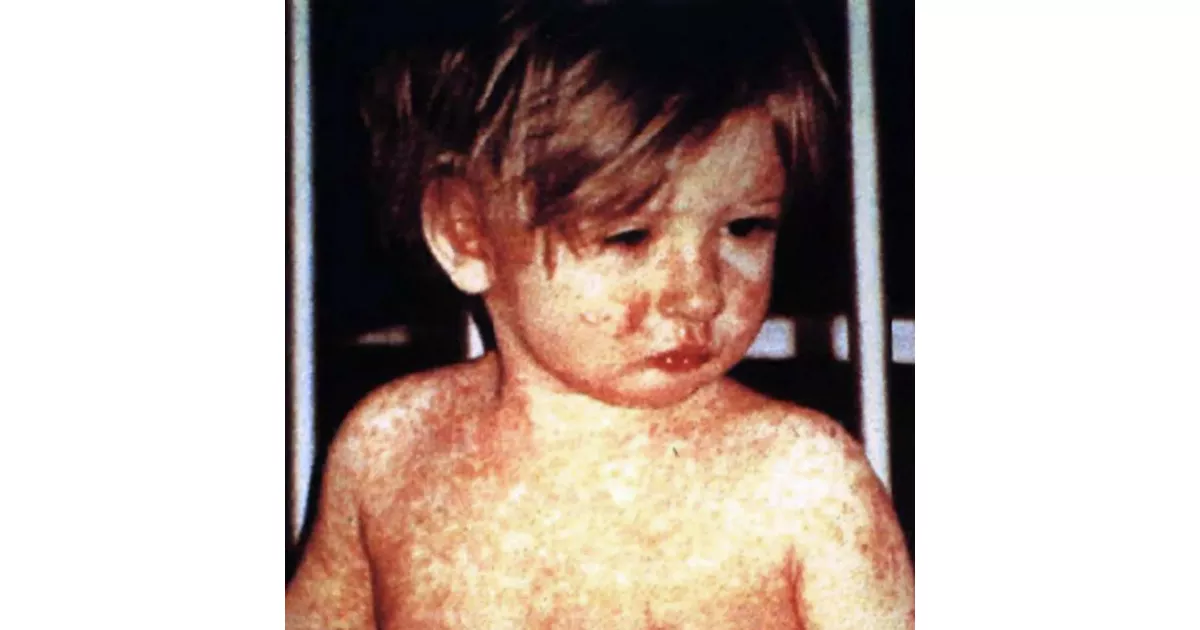Measles, also known as morbilli or rubeola, is a highly contagious infectious disease caused by the measles virus. It is vaccine-preventable. Other historical names include 9-day measles, red measles, and English measles. Due to its contagiousness, vaccination efforts are crucial for preventing outbreaks.
1914: Measles Mortality Statistics
In 1914, a statistician for the Prudential Insurance Company estimated from a survey of 22 countries that 1% of all deaths in the temperate zone were caused by measles, with 1-6% of cases ending fatally depending on age, social conditions, and pre-existing health conditions.
1954: Isolation of the Measles Virus
In 1954, John Enders and Thomas C. Peebles isolated the measles virus from a 13-year-old boy named David Edmonston in the United States, using techniques similar to those used for poliovirus propagation.
1957: Presumptive evidence of immunity before 1957
According to the US Centers for Disease Control and Prevention, birth before 1957 is presumptive evidence of immunity.
1957: Critical community size for measles
In 1957, M.S. Bartlett recognized the concept of the critical community size (CCS) for measles, referring to the minimum number supporting measles.
1963: First Measles Vaccine Developed
In 1963, Maurice Hilleman at Merck used the Edmonston B strain to develop the first successful measles vaccine, which became widely available in the United States.
1968: Improved Measles Vaccine Available
In 1968, an improved measles vaccine became available, offering enhanced protection against the disease.
1971: MMR Vaccine Licensed in the US
In 1971, the measles vaccine was combined with the mumps vaccine and rubella vaccine to create the MMR vaccine, which was licensed for use in the United States.
1980: Measles deaths worldwide
In 1980, 2.6 million people died from measles worldwide.
1985: Measles death rate reported in U.S.
Among cases reported in the U.S. between 1985 and 1992, death occurred in 0.2% of cases, but may be up to 10% in people with malnutrition.
1987: Case fatality rate across the United States
Between 1987 and 2000, the case fatality rate across the United States was three deaths per 1,000 cases attributable to measles, or 0.3%.
1990: Measles deaths worldwide
In 1990, 545,000 people died from measles worldwide.
1991: Measles Outbreak in Philadelphia
In 1991, Philadelphia experienced a measles outbreak centered at the Faith Tabernacle Congregation, a faith-healing church that discouraged vaccination, resulting in over 1,400 infections and nine child deaths.
1992: Measles death rate reported in U.S.
Among cases reported in the U.S. between 1985 and 1992, death occurred in 0.2% of cases, but may be up to 10% in people with malnutrition.
1992: US Measles Cases
As of December 2019, the 1,282 confirmed individual cases of measles was the greatest number of cases reported in the US since 1992.
1996: Global cases increased
By 2019 cases had increased to a total of 870,000, the highest since 1996.
1997: Measles Cases in Europe
In 1997, the number of measles cases in Europe was lower than the 127,350 cases reported in 2024, which was the highest caseload since 1997.
1999: Measles deaths worldwide
Globally, measles deaths fell 60% from an estimated 873,000 in 1999 to 345,000 in 2005.
2000: Measles declared eliminated in the US
As of April 2019, the 695 measles cases reported was the highest number of measles cases since measles was declared eliminated in 2000.
2000: Case fatality rate across the United States
Between 1987 and 2000, the case fatality rate across the United States was three deaths per 1,000 cases attributable to measles, or 0.3%.
2000: Global cases decreased
Between 2000 and 2016, global cases decreased by 84%.
2000: Establishment of the Global Measles and Rubella Laboratory Network
In 2000, the WHO established the Global Measles and Rubella Laboratory Network (GMRLN) to provide laboratory surveillance for measles, rubella, and congenital rubella syndrome.
2000: 80% decrease in deaths from measles
Vaccination resulted in an 80% decrease in deaths from measles between 2000 and 2017.
2001: Measles Cases in the U.S.
Between 2001 and 2011, there were 911 cases of measles reported in the United States after it was declared free of circulating measles in 2000.
2001: Eradication of rinderpest, a cattle virus
In 2001, rinderpest, a cattle virus closely related to the measles virus, was eradicated.
2003: Last U.S. Measles Fatality Before 2015
Prior to the 2015 measles fatality in Washington state, the last measles-related death in the U.S. occurred in 2003.
2005: Measles deaths worldwide
Globally, measles deaths fell 60% from an estimated 873,000 in 1999 to 345,000 in 2005.
2005: MMRV Vaccine Licensed
In 2005, the MMR vaccine was combined with the varicella vaccine to create the MMRV vaccine, which was licensed.
2007: Measles death rate in England and Wales
From 2007 to 2017 in England and Wales death occurred between two and three cases out of 10,000.
2008: Measles deaths worldwide
Estimates for 2008 indicate measles deaths fell further to 164,000 globally, with 77% of the remaining measles deaths in 2008 occurring within the Southeast Asian region.
2011: Measles Cases in the U.S.
Between 2001 and 2011, there were 911 cases of measles reported in the United States after it was declared free of circulating measles in 2000.
2011: Stefan Lanka's Measles Challenge
In 2011, German anti-vaccination campaigner Stefan Lanka offered €100,000 for scientific proof that measles is caused by a virus and for determining the virus's diameter, claiming the illness is psychosomatic. Despite evidence provided by physician David Bardens, Lanka refused to accept it, leading to a court case where Lanka was ultimately not required to pay the award due to the evidence not meeting his exact requirements. Steven Novella called Lanka "a crank".
2011: WHO estimates of deaths caused by measles
In 2011, the WHO estimated that 158,000 deaths were caused by measles.
2012: Decrease in deaths due to measles
In 2012, the number of deaths due to measles was 78% lower than in 2000 due to increased rates of immunization among UN member states.
2013: Measles cases in Europe
In 2013–14, there were almost 10,000 cases in 30 European countries. Most cases occurred in unvaccinated individuals and over 90% of cases occurred in Germany, Italy, Netherlands, Romania, and United Kingdom.
October 2014: Measles outbreak in Berlin
Between October 2014 and March 2015, a measles outbreak in the German capital of Berlin resulted in at least 782 cases.
December 2014: Disneyland Measles Outbreak
In late December 2014, an outbreak of measles was believed to have originated at Disneyland in California, leading to the infection of 147 people across seven U.S. states, Mexico, and Canada; of those infected, 48% were unvaccinated and 38% were unsure of their vaccination status.
2014: Global vaccination programs reduce measles deaths
By 2014, global vaccination programs had reduced the number of deaths from measles to 73,000.
2014: Measles Outbreak in Ohio
In 2014, an outbreak of measles occurred in Ohio after two unvaccinated Amish men returned from missionary work in the Philippines, leading to 383 cases across nine counties, with 89% of cases occurring in unvaccinated individuals.
2014: CDC: Endemic Measles, Rubella, and Congenital Rubella Syndrome Absent in the US
In 2014, the CDC reported that endemic measles, rubella, and congenital rubella syndrome had not returned to the United States, although occasional outbreaks persisted due to imported cases, highlighting the importance of continued measles vaccination.
2014: Vietnamese Measles Epidemic
In the spring of 2014, an estimated 8,500 measles cases with 114 fatalities had been reported in the Vietnamese measles epidemic as of April 19, increasing to 21,639 suspected measles cases with 142 measles-related fatalities by May 30.
March 2015: Measles outbreak in Berlin
Between October 2014 and March 2015, a measles outbreak in the German capital of Berlin resulted in at least 782 cases.
April 2015: Measles Cases Reported to CDC
Between January 4 and April 2, 2015, the CDC reported 159 cases of measles, with 70% linked to an earlier exposure in late December 2014, believed to have originated from Disneyland in California.
2015: Measles Death in Washington State
In 2015, a vaccinated woman in Washington state taking immunosuppressive drugs died of pneumonia resulting from a measles infection, marking the first measles-related fatality in the U.S. since 2003.
2015: First Measles Death Since 2015
On 26 February 2025, the first measles death since 2015 was reported to be that of an unvaccinated school-aged child in West Texas.
August 2016: Measles Outbreak in Myanmar
In August 2016, at least 40 children died during a measles outbreak in the Naga Self-Administered Zone in a remote northern region of Myanmar, likely due to lack of vaccination and poor health infrastructure.
2016: Cochrane review of vitamin A supplementation for measles
A 2016 Cochrane review of two randomised controlled trials (RCTs) assessed the effectiveness of vitamin A supplementation in children with measles, concluding that no trials were found that assessed whether vitamin A supplementation in children with measles prevents blindness.
2016: Global cases decreased
Between 2000 and 2016, global cases decreased by 84%.
2016: Measles virus genotypes are decreasing
Data from 2016 to 2018 show that the most frequently detected measles virus genotypes are decreasing, suggesting that increasing global population immunity has decreased the number of chains of transmission.
2016: Brazil won a measles elimination certificate
In 2016 Brazil won a measles elimination certificate by the Pan American Health Organization. The country has struggled to keep this certificate, since two outbreaks had already been identified in 2018.
2016: Record low of measles cases in Europe
In 2016, a record low of 4,400 measles cases in Europe were reported.
2016: Measles Eliminated from the Americas
In 2016, measles was declared eliminated from the Americas as a result of widespread vaccination efforts.
2016: Measles Interrupted in Brazil
In 2016, the spread of measles had been interrupted in Brazil, with the last-known case occurring twelve months earlier in the state of Ceará.
June 2017: First Measles Case in Maine in 20 Years
In June 2017, a case of measles was confirmed in Franklin County, Maine, marking the first instance of the disease in the state in 20 years.
2017: Measles vaccination statistics worldwide
As of 2017, about 85% of children worldwide had received their first dose of the measles vaccine. Vaccination resulted in an 80% decrease in deaths from measles between 2000 and 2017.
2017: Measles death rate in England and Wales
From 2007 to 2017 in England and Wales death occurred between two and three cases out of 10,000.
2017: Measles resurgence in Europe
From 2017, a measles resurgence in Europe started to occur with numbers increasing in that year to 21,315 cases, with 35 deaths.
2017: Measles reproductive number estimates review
In 2017, a review of measles's reproductive number estimates provided a range of 3.7 to 203.3, varying beyond the frequently cited range of 12 to 18.
2017: Measles Cases Return to the Americas
In 2017, measles cases reappeared in the Americas after the disease had been declared eliminated in 2016 due to widespread vaccination.
2017: Measles Cases in Brooklyn
In 2017, there were only two cases of measles in Brooklyn before a spike that resulted in 285 cases in 2018.
2017: Measles deaths worldwide
There were 142,300 measles related deaths globally in 2018, of which most cases were reported from African and eastern Mediterranean regions. These estimates were slightly higher than that of 2017, when 124,000 deaths were reported due to measles infection globally.
July 2018: Measles Case in Portland, Oregon
In July 2018, one case of measles occurred in Portland, Oregon, exposing 500 people, with 40 lacking immunity and being monitored by county health officials as of July 2, 2018.
October 2018: Measles Outbreak in Brooklyn
Beginning in October 2018, an outbreak of measles occurred in Brooklyn, New York, resulting in over 200 reported cases by February 2019, with the outbreak being tied to population density of the Orthodox Jewish community.
2018: Measles Outbreak
A measles outbreak in 2018 resulted in well beyond 115,000 cases and over 1,200 deaths.
2018: Measles remains a leading cause of vaccine-preventable deaths
As of 2018, measles remains a leading cause of vaccine-preventable deaths in the world.
2018: Measles virus genotypes are decreasing
Data from 2016 to 2018 show that the most frequently detected measles virus genotypes are decreasing, suggesting that increasing global population immunity has decreased the number of chains of transmission.
2018: Measles Cases Reported in the Americas
In 2018, measles cases were reported again in the Americas, despite the disease having been declared eliminated in 2016.
2018: Measles Vaccination Rate in Samoa
In 2018, the measles vaccination rate in Samoa was 31 to 34% before increasing to 94% in December 2019 due to a vaccination campaign.
2018: Measles Cases in Brooklyn
In 2018, there were 285 cases of measles centered on the Orthodox Jewish areas of Brooklyn.
2018: Increase in measles cases in Europe
In preliminary figures for 2018, reported measles cases in Europe increased 3-fold to 82,596 in 47 countries, with 72 deaths; Ukraine had the most cases (53,218).
2018: Measles deaths worldwide
There were 142,300 measles related deaths globally in 2018, of which most cases were reported from African and eastern Mediterranean regions. These estimates were slightly higher than that of 2017, when 124,000 deaths were reported due to measles infection globally.
February 2019: Measles Outbreak in Brooklyn Continues
From October 2018 to February 2019, an outbreak of measles in Brooklyn resulted in over 200 reported cases, linked to population density within the Orthodox Jewish community, with the initial exposure coming from an unvaccinated child visiting Israel.
April 2019: Measles Outbreaks in Multiple US States
In April 2019, measles outbreaks were reported in multiple U.S. states, including New York, California, New Jersey, and Michigan, with 695 cases reported across 22 states as of April 2019, leading to a public health emergency declaration in New York City.
April 2019: Highest Number of Measles Cases Since Elimination
As of April 2019, the U.S. reported 695 cases of measles, marking the highest number since measles was declared eliminated in 2000.
May 2019: Measles Among Malaysian Orang Asli
From May 2019, a measles outbreak occurred among the Malaysian Orang Asli sub-group of Batek people in the state of Kelantan, causing the deaths of 15 from the tribe.
December 2019: Measles Cases in the US
From January to December 2019, 1,282 individual cases of measles were confirmed in 31 states in the US. 128 of the people who got measles were hospitalized, and 61 reported having complications, including pneumonia and encephalitis.
December 2019: Measles Vaccination Campaign in Samoa
In December 2019, a vaccination campaign in Samoa brought the measles vaccination rate from 31-34% in 2018 to an estimated 94% of the eligible population, following a measles outbreak that resulted in over 5,700 cases and 83 deaths.
2019: Global cases increased
By 2019 cases had increased to a total of 870,000, the highest since 1996.
2019: Increase in disease and deaths due to decreased immunization
From 2017 to 2019 rates of disease and deaths increased due to a decrease in immunization.
2019: Large Measles Epidemic
In 2019, a measles outbreak with nearly 5,000 deaths and 250,000 infections occurred, spreading to all provinces in the country and primarily affecting children under five years old, identified by the WHO as the world's largest and fastest-moving epidemic.
2019: Measles Cases Reported in the Americas
In 2019, measles cases were reported again in the Americas, despite the disease having been declared eliminated in 2016.
2019: Countries lose measles-free status and measles cases in Europe
In 2019, the United Kingdom, Albania, the Czech Republic, and Greece lost their measles-free status due to ongoing and prolonged spread of the disease in these countries. In the first 6 months of 2019, 90,000 cases occurred in Europe.
2020: Measles Cases fall to pre-outbreak levels
Following the end of the 2019 outbreak, reported cases fell to pre-outbreak levels: 13 cases in 2020.
2020: COVID-19 pandemic hinders vaccination campaigns
In 2020, according to the WHO, the COVID-19 pandemic hindered vaccination campaigns in at least 68 countries, including in countries that were experiencing outbreaks, which caused increased risk of additional cases.
2020: Measles Cases Reported in the Americas
In 2020, measles cases were reported again in the Americas, despite the disease having been declared eliminated in 2016.
2021: Measles Cases
Following the end of the 2019 outbreak, reported cases fell to pre-outbreak levels: 49 cases in 2021.
2022: Measles Cases
Following the end of the 2019 outbreak, reported cases fell to pre-outbreak levels: 121 cases in 2022.
2023: Measles cases increase
In November 2024, the WHO and CDC reported that measles cases increased by 20% in 2023, primarily due to insufficient vaccine coverage in the world's poorest and conflict-affected regions, increasing from about 8.6 to 10.3 million cases.
February 2024: WHO reports risk of measles outbreak
In February 2024, the World Health Organization said more than half of the world was at risk of a measles outbreak due to COVID-19 pandemic-related disruptions in that month.
November 2024: WHO and CDC report increase in measles cases
In November 2024, the WHO and CDC reported that measles cases increased by 20% in 2023, primarily due to insufficient vaccine coverage in the world's poorest and conflict-affected regions, increasing from about 8.6 to 10.3 million cases.
2024: Comparison of Measles Cases in 2024 vs 2025
By March 2025, the CDC recorded 483 confirmed measles cases which already exceeded the entire 2024 total that was only 285.
2024: Measles cases increase in Europe
In 2024, Europe experienced a significant surge in measles cases, reporting 127,350 infections, the highest number since 1997. This figure represented one-third of the global measles cases, with Romania being the major center of the resurgent outbreak, reporting 30,692 cases.
2024: Measles Outbreak in Bangsamoro Region, Philippines
In 2024, a measles outbreak was declared in the Bangsamoro region in the Philippines with at least 592 cases and 3 deaths.
February 2025: Measles Outbreak and Death in Texas and New Mexico
As of February 2025, a measles outbreak was ongoing among unvaccinated communities in Texas and New Mexico. On February 26, 2025, the first measles death since 2015 was reported in West Texas, with 124 confirmed cases, mostly in children ages 5-17, according to the Texas Department of Health Services.
March 2025: CDC Reports Measles Cases Across 20 States
As of March 2025, the CDC recorded 483 confirmed measles cases across 20 states, resulting in 2 deaths and 70 hospitalizations; this number exceeds the total of 285 cases reported in all of 2024.
May 2025: Controversy surrounding vitamin A endorsement during measles outbreak
As of May 2025, during the Southwest United States measles outbreak, Robert F. Kennedy Jr., in his role as Secretary of Health and Human Services, continued to endorse vitamin A during the measles epidemic, along with other unscientific, non-vaccine measures, a response for which he has been widely criticized.
August 2025: Measles Outbreak in Alberta
In August 2025, an outbreak of measles in Alberta, Canada, led to 1800 confirmed cases, prompting health experts to urge residents to update their measles vaccinations.
2025: Measles Cases Reported in the Americas
In 2025, measles cases were reported again in the Americas, despite the disease having been declared eliminated in 2016.
2025: Measles and hypervitaminosis A in the U.S. outbreak
In the 2025 U.S. outbreak, children are presenting at hospitals with measles and hypervitaminosis A because their parents were administering vitamin A sources (supplements or cod liver oil) as attempts of protection before the children became ill with measles.
Mentioned in this timeline
Ukraine is a large country in Eastern Europe second in...
Nigeria is a West African nation the most populous in...
Venezuela officially the Bolivarian Republic of Venezuela is a country...
Sudan officially the Republic of the Sudan is a country...
Myanmar also known as Burma is a Southeast Asian country...

Disneyland located in Anaheim California is the first theme park...
Trending
7 days ago Lucas Paqueta Faces Turmoil: FA Probe and Liverpool Red Card Impact West Ham

Brett Rypien is an American professional football quarterback for the Minnesota Vikings He played college football at Boise State before...

2 months ago Luis Suárez shines as Sporting faces Napoli amid fan clashes in Champions League.

9 months ago Aniston and Pascal spark dating rumors after dinner, while Theroux reportedly weds.
6 months ago Dodgers Defeat Padres: Smith's Walk-Off Homer Secures Victory in Historic Game

Jeff Passan is a prominent American baseball sportswriter and author He is known for his in-depth reporting analysis and commentary...
Popular
Matt and Ross Duffer known as the Duffer Brothers are...

Candace Owens is an American conservative political commentator and author...

Ilhan Omar is an American politician currently serving as the...

XXXTentacion born Jahseh Dwayne Ricardo Onfroy was a controversial yet...

Tom Cotton is an American politician and Army veteran currently...
Aftyn Alyssa Behn is an American politician currently serving as...
